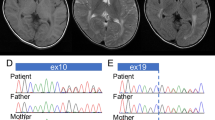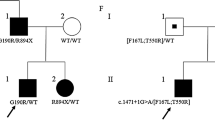Abstract
Amplification of an unstable CTG trinucleotide repeat sequence in a protein kinase gene on chromosome 19 has recently been recognised as the molecular basis of myotonic dystrophy (DM), a multisystem disorder with a wide spectrum of muscular and extramuscular manifestations. The CTG expansion of 40 patients was assessed by direct genotype analysis of the white blood cell DNA and correlated with MRI of the brain and muscles, and with functional clinical data. Cerebral pathology on MRI consisted of diffuse atrophy (68 %), subcortical white matter lesions (65 %), wide Virchow-Robin spaces (38 %) and thickening of the skull (35 %). Cerebral atrophy and extent of white matter disease correlated significantly with mental retardation, duration of disease and CTG fragment amplification. MRI of the muscular system showed fatty degeneration of different degrees in neighbouring muscles causing a mosaic pattern of the thigh in 38 % and the calf in 44 %. Muscular changes on MRI were strongly correlated with muscular impairment but less strongly with CTG expansion. Changes on MRI reflect the stage of development of tissue pathology in DM, modified by defect of the DM gene. Pathology on MRI is strongly correlated with functional deficits.
Similar content being viewed by others
Author information
Authors and Affiliations
Additional information
Received: 12 April 1995 Accepted: 25 August 1995
Rights and permissions
About this article
Cite this article
Bachmann, G., Damian, M., Koch, M. et al. The clinical and genetic correlates of MRI findings in myotonic dystrophy. Neuroradiology 38, 629–635 (1996). https://doi.org/10.1007/s002340050322
Issue Date:
DOI: https://doi.org/10.1007/s002340050322




